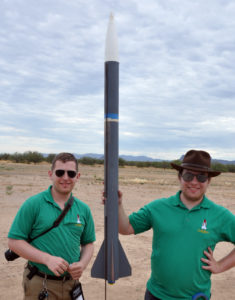Random Altitude

OVERVIEW
Random Altitude has the challenge of building and flying a model that can fly as close as possible to a Target Altitude which is not announced until shortly before the event is held.
Only one flight is allowed. If the track is lost, does not close, or if there is a Cato, a reflight will be allowed.
The model can not be radio controlled or contain any device whose purpose is to limit the altitude of the model (e.g., a wire or string).
For the full rules for this event, please see the Precision Altitude rules in the Model Rocket Sporting Code.
SCORING
For Random Altitude, the model’s tracked Altitude is calculated against the target altitude to produce a percentage error. Lowest percentage error wins.
 GENERAL TIPS
GENERAL TIPS
The Target Altitude is a value between 100 and 300 meters, in increments of 5 meters. The altitude is chosen by a random selection method immediately prior to the event.
As an example, let’s say the Target Altitude chosen for the day was 200 meters. If one model flies to 180 meters, and another model flies to 220 meters, both being 20 meters off from the target of 200, both would get a score of 10%. A model that flies to 196 meters, or to 204 meters would get a 2% error. Remember that the 200 meter target altitude is ONLY an example here.
STRATEGIES
There are two primary strategies for Random Altitude. The first strategy is to have a series of models, each of which flies to a different altitude. For example, you could have four models targeted to 150, 200, 250, and 300 meters. The models could have a payload section to allow for some weights to adjust the height to the target value.
The second strategy is to have a very general purpose model that can fly from 100 to 300 meters. Adjustment is made by modifying payload weights, motor impulse, and/or delay time.
For both strategies, some flight testing is helpful for fine-tuning the model. Once the basic model is qualified, required adjustments can be estimated using Rocksim, OpenRocket, or similar simulation program. Some competitors might bring a laptop to the field to help calculate final adjustments.
Last tip – ASK! If you have no better idea, you can ask some fellow competitors for help. Someone might have a decent idea of how high a rocket like yours is likely to go on a given engine. Especially if you have a rocket that is a fairly popular model for the event since many people will tend to use kits for this.
MOTOR SELECTION
Any contest-certified engine(s) can be used, up to 160 N-Seconds total (G class).
KITS
Almost any kit and contest approved motor will work.